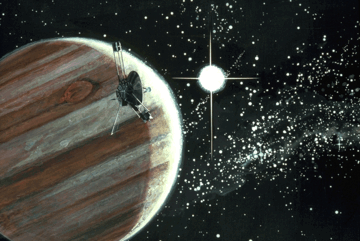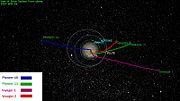Pioneer 10
 Artist's Concept of Jupiter Encounter |
|
| Organization | Ames Research Center - NASA |
|---|---|
| Mission type | Fly-by, Deep Space |
| Flyby of | Jupiter (December 3 1973), Outer Solar System |
| Launch date | 1972-03-03 at 01:49:00 UTC (13753 days ago) |
| Launch vehicle | Atlas/Centaur/TE364-4 |
| Mission duration | undefined (11283 days from launch to last contact) (last contact January 23 2003) |
| Mass | 258 kg |
Pioneer 10 (also called Pioneer-F) was the first spacecraft to travel through the asteroid belt, which it entered on July 15, 1972, and to make direct observations of Jupiter, which it passed by on December 3, 1973. It was launched from Cape Canaveral Air Force Station's Launch Complex 36A on March 2, 1972. Pioneer 10 is heading in the direction of Aldebaran, located in Taurus. By some definitions, Pioneer 10 has become the first artificial object to leave the solar system. It is surely the first human-built object to have been set upon a trajectory leading out of the solar system. However, it still has not passed the heliopause or Oort cloud[1].
Its objectives were to study the interplanetary and planetary magnetic fields; solar wind parameters; cosmic rays; transition region of the heliosphere; neutral hydrogen abundance; distribution, size, mass, flux, and velocity of dust particles; Jovian aurorae; Jovian radio waves; atmosphere of Jupiter and some of its satellites, particularly Io; and to photograph Jupiter and its satellites.
Contents |
Construction

Approved in 1969, Pioneer 10 and its sister ship Pioneer 11 were designed to live up to their names: as first-time explorers intended to both gather data and report on conditions in the asteroid belt and in Jupiter-space; how they fared would be critical in the planning and technology of any future missions.[2]
Pioneer 10 was managed as part of the Pioneer program by NASA Ames Research Center and was built by TRW.[3] It was light, at only 260 kg—30 and 27 kg of which were instruments and fuel, respectively.[4] Like the Voyagers, it was powered by radioisotope thermoelectric generators (SNAP-19s) containing plutonium-238, which provided 155W at launch, and 140W by the Jupiter flyby. The RTGs were mounted well away from the body to prevent their radiation from interfering with the spacecraft's instruments.[5]
Pioneer 10 was fitted with a plaque to serve as a message for extraterrestrial life, in the event of its discovery.
A model of Pioneer 10 is on display at the "Milestones of Flight" exhibit at the National Air and Space Museum in Washington, DC.[6]
Instruments
Instruments on the Pioneer 10 probe included:
- Helium Vector Magnetometer
- Plasma Analyzer
- Charged Particle Instrument
- Cosmic Ray Telescope
- Geiger Tube Telescope
- Trapped Radiation Detector
- Meteoroid Detector
- Asteroid-Meteoroid Experiment
- Ultraviolet Photometer
- Imaging Photopolarimeter
- Infrared Radiometer
Mission

Pioneer 10 became the first spacecraft to encounter Jupiter in December, 1973. The spacecraft then made valuable scientific investigations in the outer regions of our solar system until the end of its mission on March 31, 1997.
Further contact
Pioneer 10's weak signal continued to be tracked by the Deep Space Network as part of a new advanced concept study of chaos theory. After 1997 the probe was used in the training of flight controllers on how to acquire radio signals from space.
The last successful reception of telemetry was on April 27, 2002; subsequent signals were barely strong enough to detect. Loss of contact was probably due to a combination of increasing distance and the spacecraft's steadily weakening power source, rather than structural failure of the craft.
The last, very weak signal from Pioneer 10 was received on January 23, 2003, when it was 7.5 billion miles (12 billion kilometres) from Earth.[7]
A contact attempt on February 7, 2003 was not successful.
One final attempt was made on the evening of March 4, 2006, the last time the antenna would be correctly aligned with Earth. No response was received from Pioneer 10.[8]
Pioneer 10 is heading in the direction of the star Aldebaran in the constellation Taurus at roughly 2.6 AUs per year. If Aldebaran had zero relative velocity, it would take Pioneer 10 about 2 million years to reach it.[9]
Timeline


- March 3, 1972 Spacecraft launched.
- July 15, 1972 Entered the Asteroid Belt.
- December 3, 1973 Pioneer 10 sent back the first close-up images of Jupiter.
- June 13 1983 Pioneer 10 passed the orbit of Neptune, the outermost planet. (Although Pluto was considered to be a planet at the time, it was closer to the sun than Neptune due to its highly eccentric orbit.)
- March 31, 1997 End of mission.
- February 17, 1998 Voyager 1 overtakes Pioneer 10 as the most distant man-made object from the Sun, at 69.419 AU. Voyager 1 is moving away from the Sun over 1 AU per year faster than Pioneer 10.
- March 2, 2002 Successful reception of telemetry. 39 minutes of clean data received from a distance of 79.83 AU.
- April 27, 2002 The last successful reception of telemetry. 33 minutes of clean data received from a distance of 80.22 AU.
- January 23, 2003 The last, very weak, signal from Pioneer 10 was received. Subsequent signals were barely strong enough to detect.
- February 7, 2003 Unsuccessful contact attempt.
- December 30, 2005 Pioneer 10 was 89.7 AU away from the Sun.

- March 4, 2006 Final attempt at contact. No response was received from Pioneer 10.
Pioneer anomaly
Analysis of the radio tracking data from the Pioneer 10 and 11 spacecraft at distances between 20–70 AU from the Sun has consistently indicated the presence of a small but anomalous Doppler frequency drift. The drift can be interpreted as due to a constant acceleration of (8.74 ± 1.33) × 10−10 m/s2 directed towards the Sun. Although it is suspected that there is a systematic origin to the effect, none has been found. As a result, there is growing interest in the nature of this anomaly.
Gallery
References
- ↑ According to NASA, the Voyager 1 spacecraft reached the termination shock on 2005-05-24, Voyager 2 on 2007-08-30. Both had travelled at that time about 16 000 bil. km. The termination shock lies nearer to the Sun than the Heliopause. Pioneer 10 has reached about 15 363 bil. km on 2008-12-01 Pioneer 10 on 2008-12-01 00:00 UTC with the Solar Sysem Simulator/ So, it is clear that it hasn't reached the heliopause since 1st December 2008, and that nobody will ever know when it reaches it, as Pioneer 10 has terminated communication in 2003
- ↑ William E. Burrows, Exploring Space, (New York: Random House, 1990), p. 266-8.
- ↑ NASA mission profile
- ↑ Ibid., p. 271.
- ↑ Ibid., pp. 271-2.
- ↑ "Milestones of Flight". Smithsonian National Air and Space Museum.
- ↑ "This Month in History", Smithsonian magazine, June, 2003.
- ↑ The final attempt to contact Pioneer 10
- ↑ Spacecraft escaping the Solar System
See also
- Unmanned space missions
- Pioneer plaque
- Pioneer 11
- Voyager program
- Cassini probe
- S band
External links
- Pioneer Project Archive Page
- Pioneer 10 Profile by NASA's Solar System Exploration
- NSSDC Pioneer 10 page
- Pioneer Odyssey, NASA SP-396, 1977 - This is an entire book about the Pioneer 10 and 11 project, with all pictures and diagrams, on-line! Scroll down to click on the "Table of Contents" link.
- PIONEER 10 - Canadian rock band of same name.
- Mark Wolverton's The Depths of Space online
- A distant Pioneer whispers to Earth - CNN article, December 19, 2002
- 2005 Pioneer Anomaly Conference - Mentions March 4, 2006 Contact Attempt
| Pioneer | ||
|---|---|---|
| Previous mission: Pioneer 6, 7, 8 and 9 | Next mission: Pioneer 11 |
 |
| Pioneer 0 · Pioneer 1 · Pioneer 2 · Pioneer 3 · Pioneer 4 · Pioneer P-1 (W) · Pioneer P-3 (X) · Pioneer P-30 (Y) · Pioneer P-31 (Z) | ||
| Pioneer 5 (P-2) · Pioneer 6, 7, 8 and 9 · Pioneer 10 · Pioneer 11 · Pioneer H · Pioneer Venus project | ||
|
|||||||||||||||||||||||